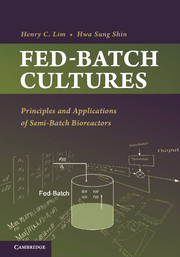Book contents
- Frontmatter
- Contents
- Preface
- Acknowledgments
- 1 Introduction to Fed-Batch Cultures
- 2 Idealized Reactors and Fed-Batch Reactors
- 3 Maximization of Reaction Rates and Fed-Batch Operation
- 4 Phenomena That Favor Fed-Batch Operations
- 5 Classification and Characteristics of Fed-Batch Cultures
- 6 Models Based on Mass Balance Equations
- 7 Non–Equation-Based Models
- 8 Specific Rate Determination
- 9 Optimization by Pontryagin's Maximum Principle
- 10 Computational Techniques
- 11 Optimization of Single and Multiple Reactions
- 12 Optimization for Cell Mass Production
- 13 Optimization for Metabolite Production
- 14 Simple Adaptive Optimization
- 15 Measurements, Estimation, and Control
- 16 Feasibility Assessment and Implementable Feed Rates
- Index
- References
4 - Phenomena That Favor Fed-Batch Operations
Published online by Cambridge University Press: 05 April 2013
- Frontmatter
- Contents
- Preface
- Acknowledgments
- 1 Introduction to Fed-Batch Cultures
- 2 Idealized Reactors and Fed-Batch Reactors
- 3 Maximization of Reaction Rates and Fed-Batch Operation
- 4 Phenomena That Favor Fed-Batch Operations
- 5 Classification and Characteristics of Fed-Batch Cultures
- 6 Models Based on Mass Balance Equations
- 7 Non–Equation-Based Models
- 8 Specific Rate Determination
- 9 Optimization by Pontryagin's Maximum Principle
- 10 Computational Techniques
- 11 Optimization of Single and Multiple Reactions
- 12 Optimization for Cell Mass Production
- 13 Optimization for Metabolite Production
- 14 Simple Adaptive Optimization
- 15 Measurements, Estimation, and Control
- 16 Feasibility Assessment and Implementable Feed Rates
- Index
- References
Summary
One of the primary objectives of reaction engineering is to optimize the rate of formation of the product (productivity) and/or the relative rates (selectivity or yield). For an existing plant, a faster product formation rate implies a higher productivity and corresponding reductions in plant operating time and operating cost. For a new plant to be built, the increased rate implies, in addition to improved productivity, a smaller reactor and therefore a lower capital investment cost. Likewise, an improved yield implies a lower raw material cost and a lower capital investment for existing and new plants.
Fed-batch operations are well suited for situations in which the cell growth and/or product formation rates are sensitive to the concentration of the limiting substrate, an intermediate, or a product so that the overall rate increases with the limiting substrate concentration, reaches a maximum, and decreases with further increases in the substrate concentration. Fed-batch operation finds wide applications in bioindustry as it takes advantages of various biochemical and physiological phenomena of cell cultures and is also able to overcome adverse physical effects. Fed-batch operations provide potential advantages for autocatalytic reactions, to which cellular processes belong, and multiple reactions in which the relative rates vary with the reactant concentration.
- Type
- Chapter
- Information
- Fed-Batch CulturesPrinciples and Applications of Semi-Batch Bioreactors, pp. 52 - 61Publisher: Cambridge University PressPrint publication year: 2013
References
- 1
- Cited by



